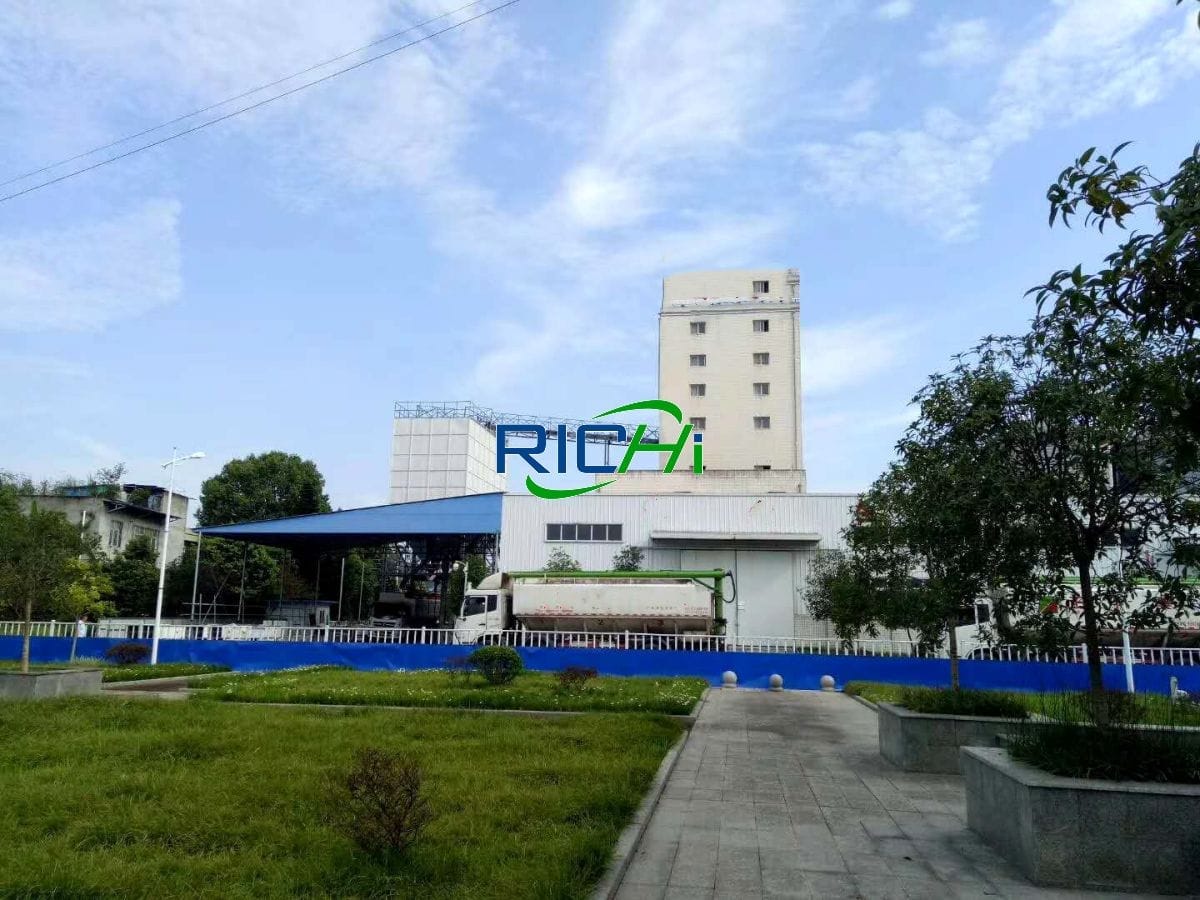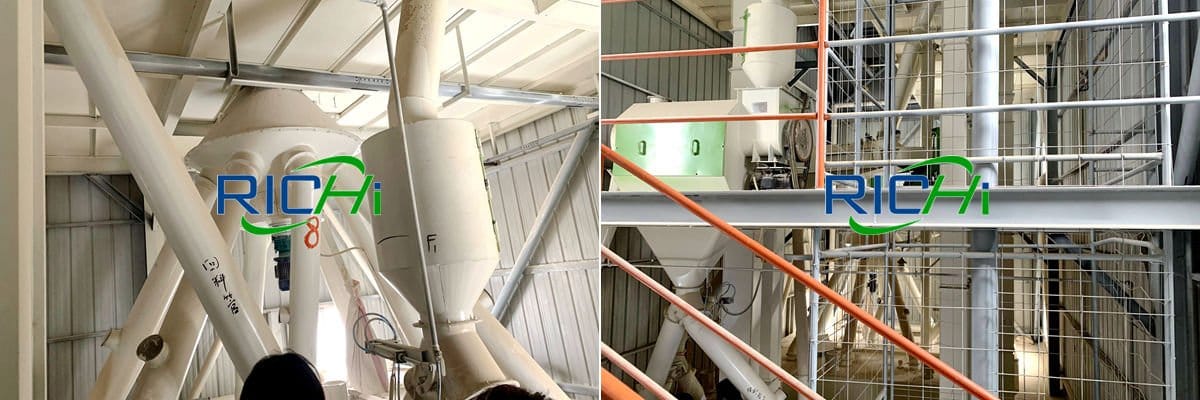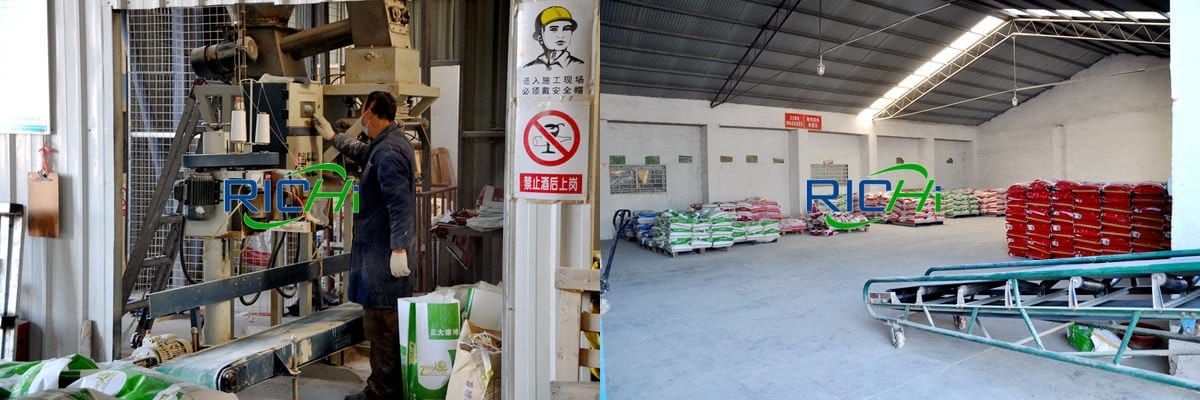Origin of 6 t/h fish feed mill plant
In the past ten years, with the sustained and rapid economic growth, people’s dietary structure has changed, which has driven the expansion of the demand for aquatic products. The acceleration of urbanization and the support of relevant national policies have increased the proportion of large-scale farming. These factors have promoted the rapid growth of feed market sales.
The client of this project invested 2 million US dollars to build an aquatic feed mill project. Mainly build a production line with 3t/h compound sinking fish pellet feed and a production line with 3t/h extruded fish feed.

- Project type: Aquatic feed production project, producing sinking fish feed and floating fish feed at the same time, adapting to different customer needs
- Nature of construction: newly built
- Construction scale: The construction area is 17857m², and the designed production capacity is 7,500 tons of compound feed and 7,500 tons of extruded feed per year, that is, 3 tons of sinking fish pellet feed & 3 tons of extruded fish feed
- Occupied area: The total area of the project is 17320.65m², which belongs to industrial land.
- Number of employees: 40
- Production system: 8 hours a day, 300 days a year
- Engineering investment: The total investment of the fish feed production plant project is 2 million US dollars (including equipment, civil engineering and other costs)
- 6T/H fish feed mill process design: The processing of sinking fish feed adopts the ring die granulation process, and the floating fish feed adopts the puffing process
- Main equipment: aquatic feed extruder, fish feed pellet machine, grease sprayer, feed grinder, mixer, screening machine, packaging machine, etc.
Construction content
The main engineering of the 6t/h fish feed mill plant project is a new production line with an annual production capacity of 7,500 tons of compound feed and a production line with an annual output of 7,500 tons of extruded feed; the auxiliary engineerings are comprehensive buildings, guards and pump rooms, etc.; public works are water supply, power supply, and heating (warm) for the aqua feed plant project , gas supply, etc.; environmental protection engineerings include wastewater treatment facilities, solid waste collection measures, and noise reduction measures.

- Production line: 1 production line with an annual output of 7,500 tons of compound feed and 1 production line with an annual output of 7,500 tons of extruded feed
- Production workshop: 1 building, construction area 10406.8m²
- Warehouse: 1 building, construction area 5400m²
- Comprehensive building: 1 block, construction area 1970.2m²
- Guard room: 1 building, construction area 45m²
- Water pump house: 1 building, construction area 35m²
The gate of this 6t/h floating fish feed plant is located on the south side of the factory area, the production workshop is located in the northern half of the factory area, the comprehensive building is located in the southwest of the factory area, and the warehouse is located in the southeast of the factory area.
The 6t/h fish feed mill plant project adopts advanced production equipment and technology, the pollutants are produced less and can meet the standard discharge, and the resources are fully utilized, so the project meets the requirements of clean production.
Consumption of energy and raw and auxiliary materials
| Name | Amount |
|---|---|
| Water | 1800t/a |
| Electricity | 1.0768 million kw.h/a |
| Flour | 3000t |
| Peanut Meal | 3000t |
| Soybean Meal | 4500t |
| Fishmeal | 3000t |
| Soybean oil | 750t |
| Vitamins, trace elements, drugs, etc. | 750t |
| Natural Gas | 140,000 m3/a |
| Boiler water (purified water) | 1200 t/a |

Main equipment for 6 t/h fish feed mill plant
| Name | QTY |
|---|---|
| Unloading pit | 1 |
| Pulse bag filter | 12 |
| Preliminary cleaning of pellets | 1 |
| Powder initial cleaning | 1 |
| Batching warehouse | 12 |
| Twin-shaft high-efficiency mixer | 2 |
| Permanent magnet cylinder | 3 |
| Store bin to be crushed | 2 |
| Cyclone | 2 |
| Flat bottom broken arch feeding bin | 1 |
| Rotary classifier | 3 |
| Flip-type cooler | 1 |
| Wet extruder | 1 |
| Circulation Box Dryer | 1 |
| Fish feed pelleting machine | 2 |
| Seam combination conveyor | 1 |
| UV Photo-Oxygen Catalytic Purifier | 1 |
| Soybean oil storage tank (5t) | 2 |
| Grease sprayer | 1 |
Process flow of 6 t/h fish feed mill plant
The feeding of this fish feed processing line project (flour, fish meal, soybean meal, peanut meal) adopts manual feeding, and the materials are sent to the primary cleaning sieve of the pellets and the primary cleaning sieve of the powder through the elevator for impurity treatment.
After the screening is completed, the material enters the batching bin through the pipeline by gravity, and then enters the double-shaft high-efficiency mixer through gravity for material mixing. machine for material mixing.

After the mixing is complete, the material is sent to the permanent magnet cylinder through the elevator for iron filings processing, and the processed material is sent to the silo to be crushed by gravity, and the material is sent to the pulverizer for coarse crushing by gravity.
After the coarse powder is completed, the material is sent to the permanent magnetic cylinder through the elevator for iron filings treatment, and the processed material is sent to the ultrafine pulverizer for ultrafine pulverization.
After the crushing is complete, it is sent to the batching bin through the elevator, and the material is sent to the double-shaft high-efficiency mixer by gravity, and at the same time, the material is added to the double-shaft fish feed mixer through manual feeding (vitamins, trace elements, drugs, etc.) for material mixing. After mixing is complete, the material is sent to the permanent magnet cylinder through the elevator for iron filings treatment.

①After the treatment is completed, the materials used to produce extruded feed are sent to the wet extruder for expansion, and the expanded materials are sent to the box dryer for drying.
After drying, they are sent to the rotary grading screen for grading treatment, and the qualified materials are sent to the buffer bin, unqualified materials are sent to the production device in the 6t/h fish feed mill plant for reproduction, qualified materials are sent to the buffer bin by gravity, and soybean oil is added to the buffer bin through a grease sprayer.
And then the materials are sent to the rotary classifier by gravity for grading treatment, and the qualified materials are sent to puffing the unqualified materials are sent to the production device in the factory area for reproduction, and the final qualified products are packaged and put into storage.

② After the treatment is completed, the materials used to produce sinking fish compound feed are sent to the flat-bottom broken arch feeding bin, and are sent to the fish feed pelletizer for granulation by gravity. After the granulation is completed, the materials are sent to the stabilizer by gravity for secondary aging.
After the curing is completed, it is sent to the flap cooler for cooling. After the cooling is completed, the material is classified by the rotary sieve. After the compound feed (large particles) is sent to the silo, it is sent to the particle cleaner for treatment by gravity. After processing, it is packed into storage.
Sinking fish pellet feed (small pellets) sends the material to the permanent magnet cylinder for iron filings treatment by gravity, and the processed feed is sent to the silo, and is sent to the crusher for processing by gravity, and the processed feed is packaged. (Related post: sinking fish feed machine)
Public works
- Power supply: The annual power consumption of the 6t/h fish feed mill plant project is 1.0768 million kw.h, and the factory is equipped with a 500KVA transformer, which is provided by the power supply system of the park, which can meet the power demand of the fish feed factory project.
- Heating (warm): production heat is provided by a 1t/h gas-fired boiler, and workers are heated by the central heating in the park in winter, which can meet the heat demand of the project. The gas-fired steam boiler uses natural gas as fuel, and the consumption of natural gas is 140,000 m3/a.
- Water supply and drainage: The domestic water supply of the project is provided by the water supply system of the park. The domestic water consumption is calculated as 60L per person per day. The project implements a shift system, and the domestic water consumption is 1800m3/a, which can meet the water demand.
The amount of domestic sewage in this 6t/h fish feed mill plant project is calculated as 80% of the water consumption, which is about 1440m3/a. The domestic sewage is treated in the septic tank and discharged into the sewage treatment plant through the sewage pipe network. Boiler water is purchased pure water, purchased 4m³ per day, which can meet the needs of this project.